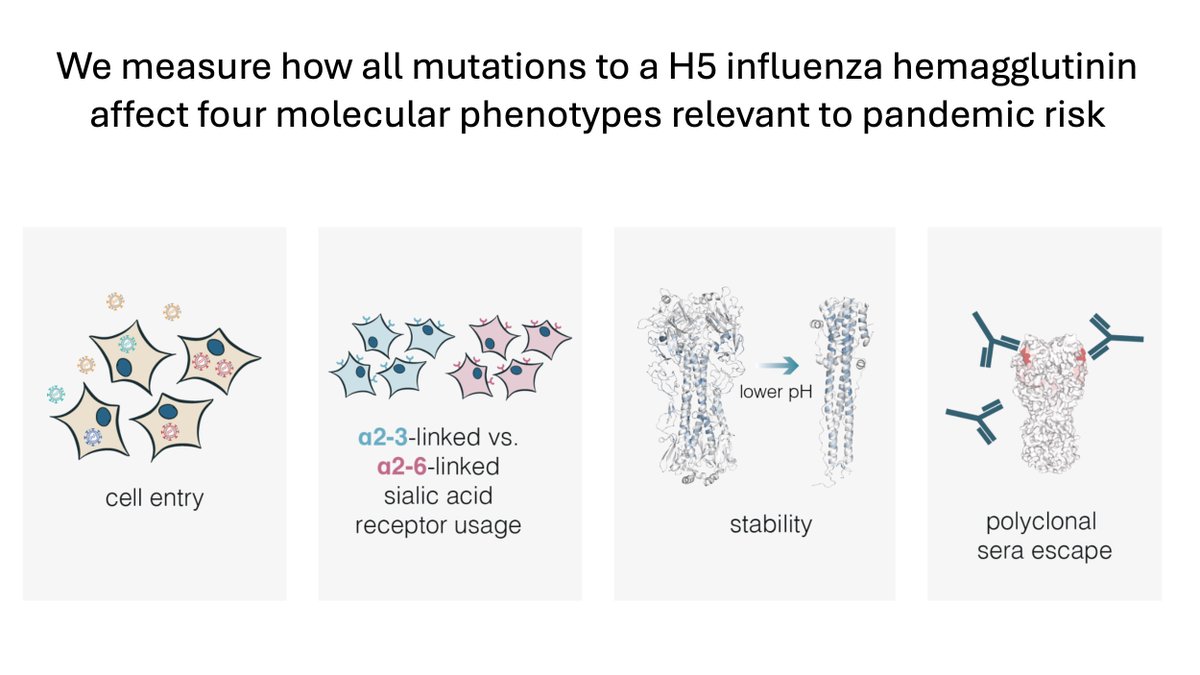In new study led by @bdadonaite, we measure how all mutations to H5 influenza HA affect four molecular phenotypes relevant to pandemic risk:
Results can inform surveillance of ongoing evolution of H5N1. biorxiv.org/content/10.110…

Results can inform surveillance of ongoing evolution of H5N1. biorxiv.org/content/10.110…

To measure how all HA mutations affect those phenotypes, we created pseudovirus libraries of HA from WHO clade 2.3.4.4b vaccine strain.
Pseudoviruses encode no genes other than HA, so can only do a single cycle of infection making them safe for biosafety-level-2.
Pseudoviruses encode no genes other than HA, so can only do a single cycle of infection making them safe for biosafety-level-2.

First, we measured how all mutations affected HA-mediated cell entry, which is essential for viral fitness
See heatmap below, which is easily visualized interactively at
Some sites constrained (orange); others w many well tolerated mutations (white/blue) dms-vep.org/Flu_H5_America…

See heatmap below, which is easily visualized interactively at
Some sites constrained (orange); others w many well tolerated mutations (white/blue) dms-vep.org/Flu_H5_America…

Here is constraint (average cell entry effect of mutations at each site) on HA structure.
These measurements define ideal targets for new approaches (eg ) to develop antibodies targeting constrained regions of virus. biorxiv.org/content/10.110…

These measurements define ideal targets for new approaches (eg ) to develop antibodies targeting constrained regions of virus. biorxiv.org/content/10.110…

Next, we measured how mutations affect HA’s usage of a2-6 vs a2-3 sialic acid receptors (thanks @PeacockFlu for idea how to do this)
Important because human-transmissible viruses use a2-6.
Below are mutations that improve a2-6 usage, and should be monitored for in surveillance
Important because human-transmissible viruses use a2-6.
Below are mutations that improve a2-6 usage, and should be monitored for in surveillance

Airborne-transmissible influenza viruses tend to have higher HA stability, so we also measured how all mutations affect stability.
As seen below, stability enhancing mutations tend to be located in helices in fusion machinery and interfaces between head & stalk domains.
As seen below, stability enhancing mutations tend to be located in helices in fusion machinery and interfaces between head & stalk domains.

In addition to relevance of stability-enhancing mutations for pandemic-risk surveillance, these mutations could be useful to introduce into vaccine immunogens as stabilizing mutations have improved immunogenicity of other viral vaccines.
We next measured how all HA mutations affected neutralization by sera from vaccinated mice (from @ScottEHensley) or ferrets (from Richard Webby).
This is important because WHO recommends candidate vaccine strains to H5, which may need to be updated as virus evolves.
This is important because WHO recommends candidate vaccine strains to H5, which may need to be updated as virus evolves.
Below are sites in HA where mutations reduce neutralization by mouse or ferret sera (see interactive plots w per-mutation effects)
These data make it possible to rapidly identify new viral mutants that are mismatched to current candidate vaccine strains. dms-vep.org/Flu_H5_America…

These data make it possible to rapidly identify new viral mutants that are mismatched to current candidate vaccine strains. dms-vep.org/Flu_H5_America…

To use these experimental datasets to inform surveillance, Jordan Ort & @LouiseHMoncla to integrated them into an interactive Nextstrain tree () that allows you to color nodes by phenotypes (see dropdown at left)nextstrain.org/groups/moncla-…
Such trees make it possible to immediately identify when new viral mutants have potentially relevant HA phenotypic changes; for instance, see below for examples of mutations in dairy cattle cluster that reduce neutralization, or viruses w increased HA stability. 

The datasets are so rich that we recommend viewing interactive plots rather than static figures:
- Homepage w all data:
- Data mapped on HA structure:
- Data mapped on phylogenetic trees: dms-vep.org/Flu_H5_America…
dms-viz.github.io/v0/?data=https…
nextstrain.org/groups/moncla-…
- Homepage w all data:
- Data mapped on HA structure:
- Data mapped on phylogenetic trees: dms-vep.org/Flu_H5_America…
dms-viz.github.io/v0/?data=https…
nextstrain.org/groups/moncla-…
In addition, we have made a page to help convert between the many confusing numbering schemes used to name HA mutations:
(Throughout we use H3 numbering, but other studies use other schemes)dms-vep.org/Flu_H5_America…
(Throughout we use H3 numbering, but other studies use other schemes)dms-vep.org/Flu_H5_America…
Finally, as we discuss in paper, our ability to safely do deep mutational scanning of H5 HA enabled by switch from live-virus to pseudovirus. I thank @mlipsitch & others for thoughtful discussion that prompted switch; we welcome continued input on those aspects of our work. 

Thanks to all who contributed to this study: @bdadonaite, @Jenny_Ahn0, Jordan Ort, Jin Yu, Colleen Furey, @anniedosey, Will Hannon, Amy Baker, Richard Webby, @KingLabIPD, Yan Liu, @ScottEHensley, @PeacockFlu, @LouiseHMoncla
Pre-print is here: biorxiv.org/content/10.110…
Pre-print is here: biorxiv.org/content/10.110…
• • •
Missing some Tweet in this thread? You can try to
force a refresh









